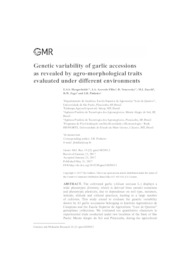Genetic variability of garlic accessions as revealed by agro-morphological traits evaluated under different environments.
Genetic variability of garlic accessions as revealed by agro-morphological traits evaluated under different environments.
Author(s): HOOGERHEIDE, E. S. S.; AZEVEDO FILHO, J. A.; VENCOVSKY, R.; ZUCCHI, M. I.; ZAGO, B. W.; PINHEIRO, B. J.
Summary: The cultivated garlic (Allium sativum L.) displays a wide phenotypic diversity, which is derived from natural mutations and phenotypic plasticity, due to dependence on soil type, moisture, latitude, altitude and cultural practices, leading to a large number of cultivars. This study aimed to evaluate the genetic variability shown by 63 garlic accessions belonging to Instituto Agronômico de Campinas and the Escola Superior de Agricultura ?Luiz de Queiroz? germplasm collections. We evaluated ten quantitative characters in experimental trials conducted under two localities of the State of São Paulo: Monte Alegre do Sul and Piracicaba, during the agricultural year of 2007, in a randomized blocks design with five replications. The Mahalanobis distance was used to measure genetic dissimilarities. The UPGMA method and Tocher?s method were used as clustering procedures. Results indicated significant variation among accessions (P < 0.01) for all evaluated characters, except for the percentage of secondary bulb growth in MAS, indicating the existence of genetic variation for bulb production, and germplasm evaluation considering different environments is more reliable for the characterization of the genotypic variability among garlic accessions, since it diminishes the environmental effects in the clustering of genotypes.
Publication year: 2017
Types of publication: Journal article
Observation
Some of Embrapa's publications are published as ePub files. To read them, use or download one of the following free software options to your computer or mobile device. Android: Google Play Books; IOS: iBooks; Windows and Linux: Calibre.
Access other publications
Access the Agricultural Research Database (BDPA) to consult Embrapa's full library collection and records.
Visit Embrapa Bookstore to purchase books and other publications sold by Embrapa.

